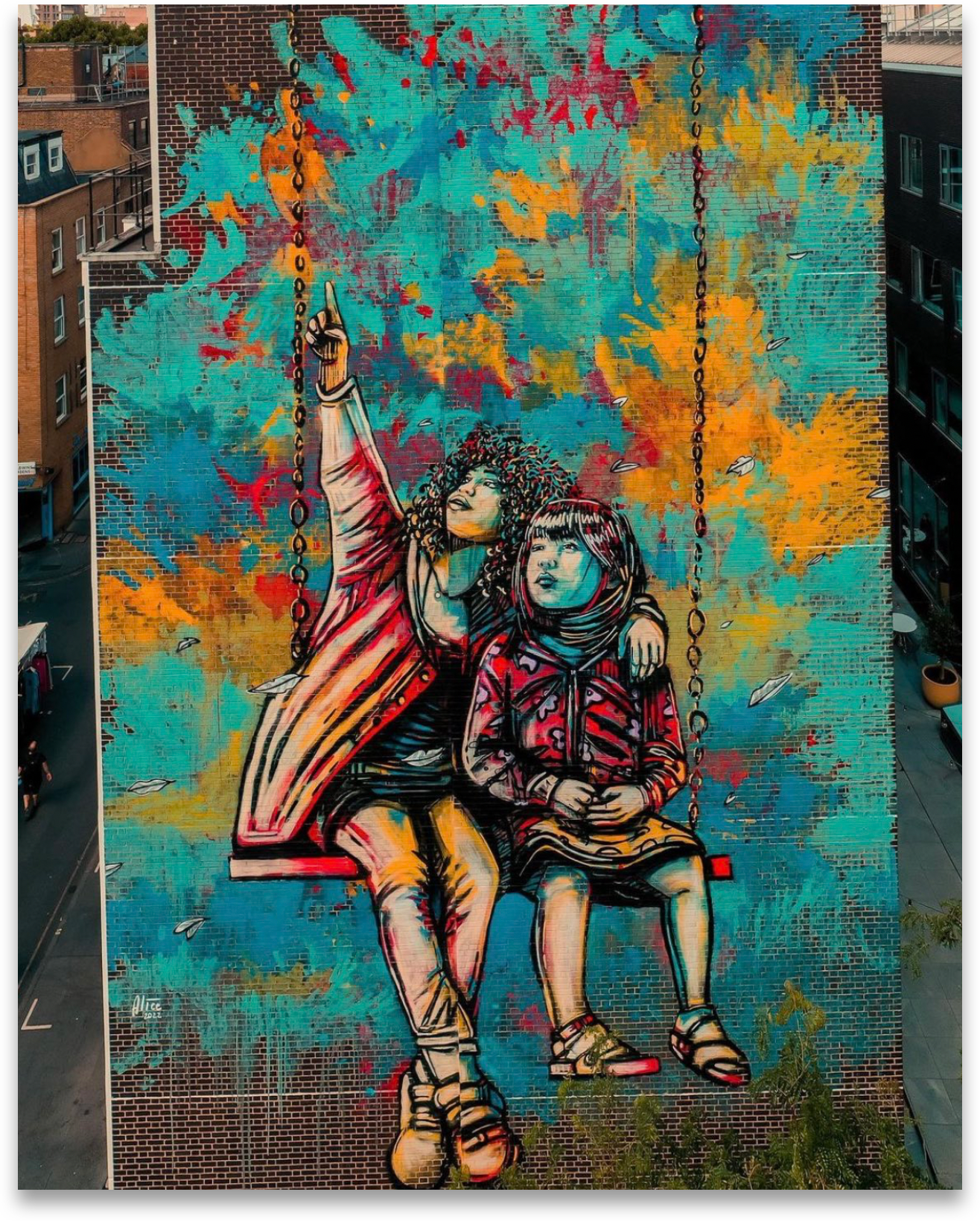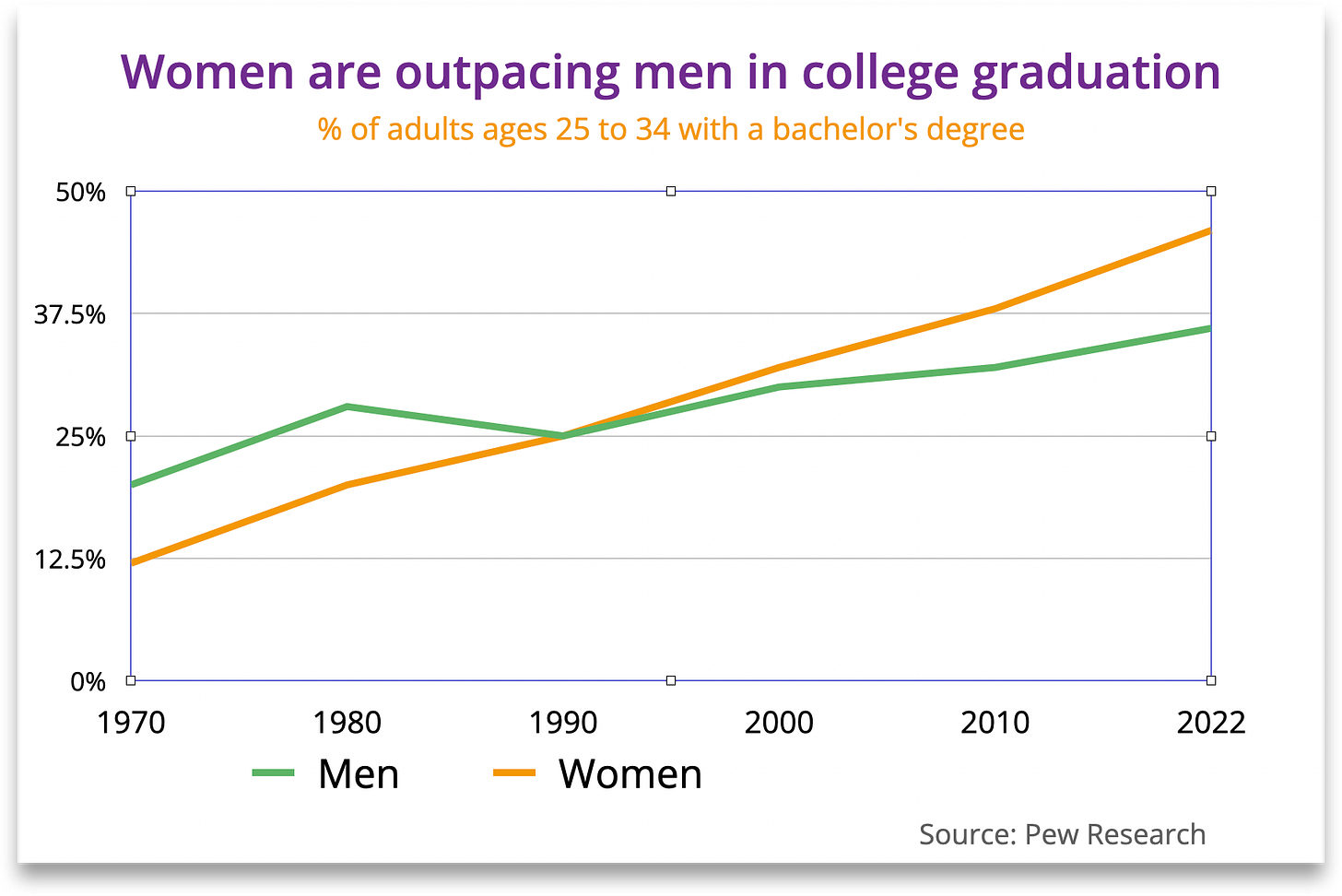Girl power accelerates while the boys are lagging
There is no difference between the average IQ or cognitive ability of women and men. Yet, Gen Z women are outpacing men across almost every success category—and the gap is getting wider.

For many reasons, most significantly because they were the last to have the right to vote in the U.S. women, by far, have been the class of people that have faced the greatest discrimination. This is why researching and writing this post gave me joy (with a mix of sadness for the boys and the mental state of the new generation). In almost every educational and professional category, women are outpacing men. On the downside of life, men are the runaway leaders. At the current rate, women will comfortably rule the world soon—and we shall all be better for it.

Our new Valedictorians
According to Pew Research, women now account for 60% of college students in the United States. Both overall and within the 25-year-old to 35-year-old set, more women earn a 4-year degree than men. Women now have a 10 percent (46% to 36%) lead over men in college graduation rates, and twice as many women as men will soon graduate from college every year.
Women also earn 59% of master's degrees and 53% of Ph.D.s. Women have earned the most doctorates for 13 straight years. Women have also benefited from numerous programs, scholarships, and inducements to increase the share of women who study STEM subjects—the only fields where men continue to earn more Ph.D.s. than women.

Part of what drives this gender gap is women’s sense of growing independence, declining faith in men as providers, and a growing desire to compete at all levels. Seventy percent of high school valedictorians are girls. Young women make up a disproportionate share of qualified applicants, and admissions committees have been practicing sub rosa affirmative action for males for many years. If college admission boards evaluated every applicant equally, Asian women would be by far the most over-represented group based on their percentage of the U.S. population. We can argue about affirmative action criteria all day, but no matter how you spin it, girls are giving up seats they’ve earned to boys at increasing levels each year.

Girls and boys are now also playing on a more even playing field in organized sports. In 2020, just over one-half of children aged 6–17 years participated in organized sports growing up. The percentage of children participating in sports was only slightly higher for boys (56%) than girls (52%). In NCAA Division I, 47% of all student-athletes are female—the most in championship sports for women. These stats are even more impressive for women considering they have fewer opportunities to participate.
Women's educational gains have occurred alongside their growing labor force participation and structural changes in the economy. The implications of the increasing gap in educational attainment for men are significant, as research has shown a strong correlation between college completion, lifetime earnings, and wealth accumulation.

Just say no and get paid more money
The share of women in the U.S. labor force has also shot from 30 percent in 1950 to plateauing at just over 46 percent recently. The Bureau of Labor Statistics indicates that the female share of the labor force will peak at 47% in 2025 and then taper off to 46% by 2060. The estimated 18-cent gender pay gap among all workers in 2022 decreased from 35 cents in 1982. And the 8-cent gap among workers ages 25 to 34 in 2022 was down from a 26-cent gap four decades earlier.

There are many nuances to these statistics, of course. In Scandinavia, for example, the number of women nurses to men is 20 to 1, and approximately the same for the number of men engineers to women engineers who, on average, make a higher wage than nurses. There are also far more women physicians than men, and there are many more professions where women dominate men. And these decisions resulted from the free choice of men and women living in societies that have strived more than any other principality to achieve gender equality.
A final primary consideration is; statistically, parenthood leads some women to put their careers on hold, whether by choice or necessity, but it has the opposite effect among men. In 2022, 70% of mothers ages 25 to 34 had a job or were looking for one, compared with 84% of women without children at home. Encouragingly, 91% of young adults between 18 and 35 see getting married as a goal in life. These lifestyle choices translate into 1.4 million mothers withdrawing yearly from the workforce.
One reason the wage gap started closing is women have been encouraged and counseled to be more formable in their negotiations. Women today are pushing for higher wages and are more willing to say 'no' in the process. The predictors of success in the marketplace are intelligence, consciousness, competency, how well one is put together and presents themself, and toughness. Today, women are more inclined to exercise their natural leadership competencies and advantages, and their rise in the workforce will continue to be very tangible.

Pay level is just one of the intractable choices people consider when mapping out and pursuing their careers. These stats demonstrate that leaving men and women free to make their own choices does not necessarily result in equal incomes on average. For most of us, having a rewarding career—a job we feel passionate about—is not measured by how much money we make. Freedom of choice and equal opportunity are desirable for individuals and society and should be the perpetual end game.
Due, in part, to their leadership at home, women make 80% of consumer decisions, which means they control significantly more influence and power in the marketplace. Single women own about 10.8 million homes in the U.S., or 2.7 million more than single men, who own approximately 8.1 million homes. Put another way, single women own an average of 13% of the owner-occupied homes in the 50 states versus 10% among single men.

The women's suffrage movement
The women's suffrage movement, led by activists like Susan B. Anthony, Ida B. Wells, Elizabeth Cady Stanton, and Alice Paul, campaigned tirelessly for decades to secure women's voting rights. They organized marches, protests, and hunger strikes, lobbied the government, and even engaged in civil disobedience to raise awareness and garner public support for their cause.
During World War I (1914-1918), women in the United States played a significant role in supporting the war effort. Their contributions to the workforce and their efforts in various social and humanitarian causes demonstrated their capabilities and commitment to their country. This strength and leadership at a critical historical moment helped shift public opinion and challenge traditional gender roles.
Women were granted the right to vote when Congress passed the 19th Amendment to the U.S. Constitution on June 4, 1919, and ratified on August 18, 1920, after three-fourths of the states (36 out of 48) approved it. It states: "The right of citizens of the United States to vote shall not be denied or abridged by the United States or any State on account of sex." This Amendment marked a significant milestone in the women's suffrage movement and extended voting rights to millions of women across the country.

Here comes Gen Z
A Deloitte Study of 22,000 Gen Z from 44 countries showed Gen Zs feel burdened by the high cost of living, are not sold on 'business," expect more from everyone, and are therefore uncertain and anxious about their futures. Of GenZ remote workers, 77% said they would look for another job if forced to come into the office.
Generation age groups
The Silent Generation: Born 1928-1945 (78-95 years old)
Baby Boomers: Born 1946-1964 (59-77 years old)
Gen X: Born 1965-1980 (43-58 years old)
Millennials (a.k.a. Gen Y): Born 1981-1996 (27-42 years old)
Gen Z: Born 1997-2012 (11-26 years old)
Gen Alpha: Born early 2010s-2025 (0-about 10 years old)
—Pew Research Center
Gen Z believes business leaders have a significant role in addressing social and environmental issues they support. This attitude comes during a period in Silicon Valley where there is a growing backlash to the politicization of the work environment. Traditionally work has been a safe space for people who joined together as a non-partisan team to grow their businesses and serve their customers.

Their fears are the high cost of living, unemployment, and climate change. Half of Gen Zs and millennials say they live paycheck to paycheck. Nearly half of Gen Zs and four in 10 millennials say they feel stressed or anxious at work all or most of the time. Along with dealing with the COVID lockdown, the spike in the cost-of-living crisis in the last few years, spurred by the largest surge in inflation in 40 years, has only fueled this anxiety,

To address their financial stress, Gen Zs and millennials often take on side jobs, postpone buying a house or starting a family, and save money by buying second-hand clothes and not having a car. Gen Zs and millennials also appreciate the life balance value of working remotely and in hybrid work situations. Three-quarters of the respondents currently working remotely say they would look for a new job if their employer asked them to work on-site full-time.
Most Gen Zs (87%) and millennials (80%) use social media to consume news and connect with friends and family. `Half of Gen Zs and millennials say social media positively impacts their life, yet more than four in 10 say it makes them feel lonely or inadequate and pressured to have an online presence. We have yet to understand social media's long-term impact, but the constant flow of information and a 24-hour news and work cycle likely adds to their high-stress levels.
Generation Z struggles with anti-social behavior and difficulty establishing and maintaining the kind of deep friendships that give us a sense of belonging, well-being, health, and happiness. The Dartmouth study says the root of this issue is the COVID lockdown, which caused social networks to shrink and made it much tougher to make friends.
Like Millennials, members of Gen Z, also called Zoomers, run a higher risk of developing a substance abuse problem than previous age groups. According to the National Institute on Drug Abuse, 24% of 12th graders used illicit drugs in 2015. The National Institute on Alcohol Abuse and Alcoholism reports that over 4.2 million 12 to 20-year-olds confessed to binge drinking. The Department of Justice reports that 1 in 6 teens has used prescription drugs to get high or alter their mood, and 10% have admitted. —Addiction Center
If there is one bright light in the last few years, the COVID lockdown proved to many bosses that commuting to the office daily can be highly unnecessary and a waste of time and personal and company resources. For example, three years after the pandemic, tech-biz-heavy downtown San Francisco still has a 40% commercial vacancy rate with no signs of changing.
These stats support the idea that businesses can and should significantly cut back on their commercial space, and their Gen Zs and millennials workforce will be happier for it. Remote workers feel that it is easier to achieve the optimum work/life balance with more flexibility in where and when they work.

Men on the down and going lower
We have covered women's progress in education and work, and now we should quickly review the dark side of statistics and how poorly men continue to perform in the life of crime and death.
Primarily due to the criminalization of drugs, the U.S. locks up more citizens per capita—a staggering 565 per 100,000— than any other country. Of the nation's 1.9 million prisoners, 91% are men, and 9% are women. In 2021, 88% (11,696 ) of the identified murder offenders in the U.S. were male, and 12% (1,690) were female. Men accounted for 80% of persons arrested for violent crimes and 63% for property crimes.
On the suicide front, then men fair no better. The highest rate of suicide is amongst middle-aged white men, who account for 70% of suicide deaths in 2021. Overall, men die by suicide at 3.9 times the rate than women.
The Mayo Clinic reports, however, that about twice as many women as men experience depression. "In addition to confronting the pressures during puberty, women contend with additional biological challenges, including premenstrual problems, pregnancy, postpartum depression, perimenopause, and menopause.” Life circumstances and cultural challenges causing stress for women include uneven power and status, work overload, and sexual or physical abuse. Given these realities, we must promote and maintain a culture that treats women with extra attention, care, and protection.

Love the one you're with (in person)
When you consider that women are doubling-down on their academic lead over men, broadly participating in organized sports, having impressive home ownership stats, etc., this signals a high level of female perseverance and confidence. Those who worked hard and willed into existence a culture that supports a woman’s right to equal treatment and opportunity in the U.S. should feel a tremendous sense of accomplishment.
In observing Gen Z, one can't help but see an irony that the most psychology-counseled and anti-depressant, behavior-correcting drug-consuming generation is so down and getting downer. The good news is correcting this downfall is not that mysterious. Yes, it's a big subject that requires much discussion and open debate, but what went wrong and how to fix it is coming into focus. To get the discussion rolling, here are some final thoughts and observations.

My mother once said to me, "You can hold your lover on the tip of your finger and your friends in the palm of your hand." There are two points of wisdom here. First, the people that matter to you are very few. This group grows and interchanges over time, but these are the people you know the best, and they know you best. What anybody else might think of you doesn't matter because they do not know you, and you don't know them.
Second, the relationships we have with our family members, the friends we have known the longest, the people we share our secrets with—this is what life is all about. Investing in and cherishing these relationships gives us true meaning and joy in life.

The greatest gift you can give someone is your time because a person's time is finite. A woman once said that when she met Mother Teresa of Calcutta, Mother looked her in the eyes like she was the only person in the world. This is the sign of a saint. It's called complete, personal attention. With social media, we have created the opposite. The new generation now seeks the approval of the crowds over those in the palm of their hands. The amount of time they look people in the eyes and engage in thoughtful conversation is going to zero. No wonder the depression. The more one turns to social media, the more lonely and depressed one will be. The deep connection between the two can no longer be denied.
Passion-driven education
Very little about our current education system makes sense, and it has everything to do with why we feed our kids so many drugs and they are still miserable. We now have a tradition of locking down our kids starting at two and a half years old for a full day of regimented learning and activities, where every kid consumes the same content regardless of interests and is measured by the same stick. This secondary education process goes on for a grueling 15 years, and kids get increasingly bored as their IQ (and self-worth) is tallied along the way based upon if you "test well" and how much your parents strong-arm your teachers.
We have lost sight of the goal of education for our kids. Ideally, they would find and develop a passion they can pursue, make a living, and support themselves. A mere third of college graduates younger than 50 say their college experience was useful in helping them develop skills and knowledge they could parlay into the workplace.

The more personalized a kid's education is, the better they will learn and benefit. The kids that learn the most are home-schooled because they get the most personal attention and are left with more free time to explore and pursue their interests independently.
The extended robotic lockdown approach to education is unnatural for many and leads kids to prescription drugs. The testing, grading, and admission standards are very narrow and favor people with math and standardized testing skills. By one analysis, intelligence has twelve forms, which are visual-spatial, verbal-linguistic, musical-rhythmic, logical-mathematical, interpersonal, intrapersonal, naturalistic, and bodily-kinesthetic. How many of these are covered on the SAT? Today's education system leaves a lot of very smart people feeling not so smart.
The current educational system still favors the wealthy, has broken admissions programs, and offers mass-produced curriculums that are often ideologically driven and devoid of real-world value. And how much are we paying for this? People in the U.S. owe $1.78 trillion in federal and private student loan debt. The ROI is not there, with so many other options to learn in more impactful ways at a fraction of the price.
Simply put, we are driving our kids over cliffs by pitting them against each other in school, creating artificial distinctions and deadlines, enrolling them in mediocre and impersonal programs, and loading them up with debt. Instead, young people could start pursuing more personalized courses and educational experiences beginning as early as 6th grade, where they are evaluated and counseled individually, and their achievements can be mutually validated and recorded on immutable blockchain applications. Learning and education is a life-long endeavor where we build our transcripts all along the way by documenting all our work and educational experiences without needing central institutions to validate our achievements.
This is, of course, a vast subject that we intend to cover closely. Suicide is now the leading cause of death for 13-and 14-year-olds, having doubled in the last ten years. Things are not improving. They're getting worse. The fact Silicon Valley has one of the highest teenage suicide rates in the U.S. due largely to academic stress only underlines how serious of a problem we are confronting. Silicon Valley is known for creating global trends; this is one we want to disrupt, not spread.
Alice Pasquini (Rome 1980) aka Alicè is a contemporary artist whose works are exhibited on urban surfaces, in galleries and museums in hundreds of cities around the world.
Italian street artist, illustrator and set designer, she obtained a diploma in painting at the Academy of Fine Arts in Rome, completing her studies in Spain with a Master of Arts in art criticism at the Complutense University (2004) and a animation course at the Ars Animation School in Madrid.
A versatile artist, she has experimented with different techniques, genres and expressive mediums. She is among the few internationally established female exponents among the protagonists of the street art movement. On the street, his works range from small interventions on street furniture to large-scale murals.
Her research varies from the narration of female vitality, far from the woman-object stereotype, to installations with the use of unusual materials. Her works can be seen in various cities where she has been called upon to create public works commissioned by the state, including: Sydney, Moscow, Singapore, Amsterdam, London, Berlin, Oslo, New York, Buenos Aires, Yogyakarta, Barcelona, Copenhagen, Marrakech , Saigon, Rome and Naples.
It has been reviewed by newspapers such as the International New York Times, Wall Street Journal, La Vanguardia, Euromaxx, Panorama, Internazionale, Repubblica and Il Messaggero and hosted by Rai, Sky Arte and Arte TV for numerous interviews and dedicated services. In 2017 he participated in the Tedx Talks.
In 2013 he created a cycle for the Capitoline Museums in Rome and collaborated with the Italian Cultural Institute of Singapore, with the Montevideo Cultural Institute, with the São Paulo Cultural Institute, and the Italian Museum of Melbourne emigration.
Among his projects, Under Layers stands out, the first 3D street art experiment created in Ostia (Rm) in 2015 in collaboration with the Municipality of Rome.
Since 2015 Alice has been involved in the rediscovery and enhancement of the ancient center of Civitacampomarano and as artistic director of the CVTà Street Fest since 2016.
He has exhibited at the Saatchi Gallery, at the American Embassy in Rome, at the MACRO - Museum of Contemporary Art in Rome, Mutuo Centro de Arte Barcellona, at the Espace Pierre Cardin. It is included in the online Treccani Encyclopaedia Treccani Enciclopedia Italiana.Women may never make up half of the U.S. workforce
What’s behind the growing gap between men and women in college completion?
The Enduring Grip of the Gender Pay Gap
Boys left behind: Education gender gaps across the US










